Sportswear: Function, Fashion, and Everyday Clothing
Sportswear covers a wide range of garments designed for movement, comfort, and style. Today it spans everything from technical activewear used in athletic training to casual athleisure pieces worn for everyday life. This article explains how sportswear differs from conventional clothing, what to look for in performance pieces, how fashion trends shape designs, and practical guidance for choosing fabrics and fits that suit both activity and routine wear.

sportswear and performance: what to look for
Performance-focused sportswear prioritizes function: moisture management, breathability, stretch, and durability. Look for fabrics labeled with moisture-wicking or quick-dry properties, flatlock seams to reduce chafing, and four-way stretch for unrestricted movement. Fit matters — a close but non-restrictive cut often works best for high-intensity use, while looser silhouettes can be preferable for low-impact activities. Technical details such as gussets, reinforced panels, and ventilation zones signal garments engineered for sport rather than purely aesthetic clothing.
How activewear differs from regular clothing
Activewear is specifically engineered to support physical activity through material and construction choices. Unlike everyday clothing, activewear often uses synthetic fibers like polyester, nylon, or elastane blends to enhance stretch and moisture control. Seams are placed to minimize irritation, and components like elastic waistbands and performance zippers are designed for repeated movement. While regular clothing focuses on appearance and general comfort, activewear balances function with comfort, making it a practical option for exercise and travel days when mobility and quick-drying properties are priorities.
Athleisure trends in contemporary fashion
Athleisure bridges sport and streetwear, merging activewear functionality with fashion sensibilities. This trend has popularized pieces like leggings, technical hoodies, and sneakers as acceptable daily attire across many settings. Designers incorporate elevated materials, minimalist color palettes, and tailored silhouettes to make items versatile for workplace‑casual, errands, and social outings. The rise of athleisure also encouraged collaborations between sports brands and high-fashion labels, bringing innovative fabrics and refined cuts to mainstream clothing while opening new roles for sportswear in lifestyle wardrobes.
Sustainable materials in sportswear and clothing
Sustainability is influencing material choices in sportswear and general clothing. Recycled polyester, organic cotton, and plant-based performance fibers offer reduced environmental footprints compared with virgin synthetic fabrics. Brands may use closed-loop manufacturing or adopt water-saving dyeing processes to cut resource use. However, durability remains key: longer-lasting garments reduce overall environmental impact by avoiding frequent replacement. Consumers should check for transparent supply chains, certifications, and clear care instructions to ensure sustainable items perform well and last through multiple wash cycles.
Choosing the right fit for activewear and athleisure
Selecting the right fit depends on intended use and personal comfort. For high-intensity workouts, look for compression or snug fits that support muscles and minimize movement of fabric; for yoga or pilates, choose pieces with a wide range of stretch and a secure waistband. Athleisure pieces typically benefit from slightly relaxed or tailored fits that layer well over performance basics. Consider length, rise, and arm mobility when trying on items, and test movement—squat, lunge, or reach—to evaluate whether the garment maintains coverage and comfort during typical activities.
Conclusion
Sportswear now plays multiple roles: enhancing athletic performance, providing comfortable everyday clothing, and influencing contemporary fashion through the athleisure movement. Understanding fabric technology, construction features, fit, and sustainability helps consumers choose garments that meet both functional needs and style preferences. Whether you prioritize technical activewear for training or versatile pieces for daily life, informed choices make it easier to build a wardrobe that balances movement, comfort, and long-term value.






